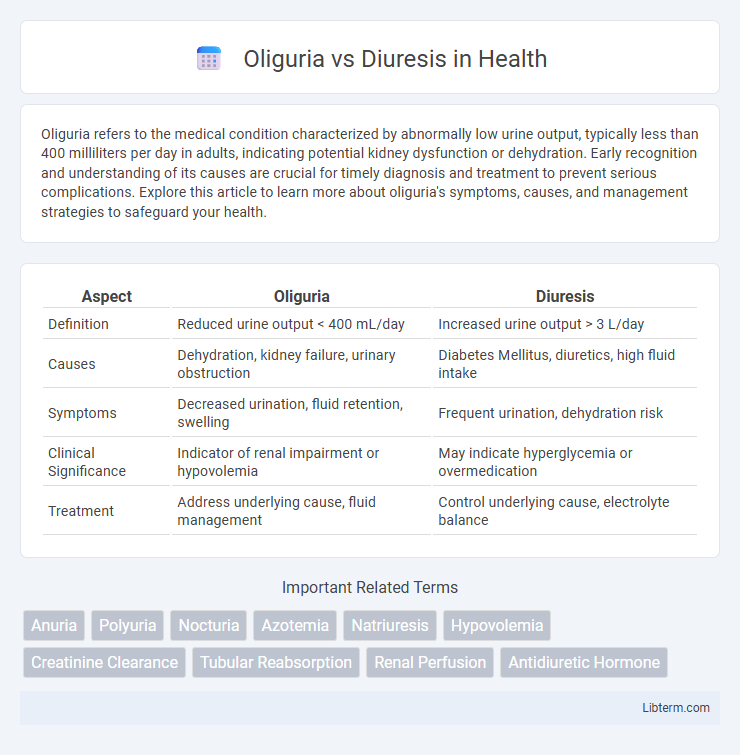Oliguria refers to the medical condition characterized by abnormally low urine output, typically less than 400 milliliters per day in adults, indicating potential kidney dysfunction or dehydration. Early recognition and understanding of its causes are crucial for timely diagnosis and treatment to prevent serious complications. Explore this article to learn more about oliguria's symptoms, causes, and management strategies to safeguard your health.
Table of Comparison
| Aspect | Oliguria | Diuresis |
|---|---|---|
| Definition | Reduced urine output < 400 mL/day | Increased urine output > 3 L/day |
| Causes | Dehydration, kidney failure, urinary obstruction | Diabetes Mellitus, diuretics, high fluid intake |
| Symptoms | Decreased urination, fluid retention, swelling | Frequent urination, dehydration risk |
| Clinical Significance | Indicator of renal impairment or hypovolemia | May indicate hyperglycemia or overmedication |
| Treatment | Address underlying cause, fluid management | Control underlying cause, electrolyte balance |
Introduction to Oliguria and Diuresis
Oliguria refers to a decreased urine output, typically less than 400 milliliters per day in adults, signaling potential kidney dysfunction or dehydration. Diuresis is the increased production and excretion of urine, often induced by factors such as diuretic medications or fluid overload. Monitoring these urinary patterns is crucial for assessing renal health and fluid balance in clinical settings.
Definition of Oliguria
Oliguria is defined as a reduced urine output, typically less than 400 milliliters per day in adults, indicating impaired kidney function or dehydration. This condition contrasts with diuresis, which involves increased urine production, often exceeding 2,500 milliliters per day, and can result from medication, diuretics, or physiological responses. Monitoring urine volume is essential for diagnosing renal health and distinguishing between oliguria and diuresis in clinical settings.
Definition of Diuresis
Diuresis is the increased production and excretion of urine, often resulting from the use of diuretics or physiological responses to excess fluid intake. This process promotes the removal of excess water and electrolytes from the body, aiding in fluid balance and blood pressure regulation. In contrast, oliguria refers to the decreased urine output, typically less than 400 mL per day, indicating potential kidney dysfunction or dehydration.
Key Differences Between Oliguria and Diuresis
Oliguria is characterized by abnormally low urine output, typically less than 400 milliliters per day, indicating potential kidney dysfunction or fluid imbalance. Diuresis involves increased urine production, often exceeding 2.5 liters per day, commonly induced by diuretic medications or conditions like diabetes insipidus. The key difference lies in urine volume regulation, where oliguria signals impaired renal clearance and fluid retention, while diuresis represents enhanced renal excretion and fluid loss.
Causes of Oliguria
Oliguria, defined as urine output less than 400 mL per day, commonly results from causes such as dehydration, acute kidney injury, urinary tract obstruction, and severe infections like sepsis. In contrast, diuresis involves increased urine production and often occurs due to diuretics administration, uncontrolled diabetes mellitus, or certain renal conditions. Understanding the underlying causes of oliguria is crucial for timely diagnosis and management to prevent complications like electrolyte imbalances and renal failure.
Causes of Diuresis
Diuresis is primarily caused by factors that increase urine production, such as diuretics, high fluid intake, and certain medical conditions like diabetes insipidus and hypercalcemia. It can also result from osmotic diuresis due to elevated blood glucose levels in uncontrolled diabetes mellitus. Understanding these causes is essential for distinguishing diuresis from oliguria, which is characterized by decreased urine output.
Symptoms and Clinical Presentation
Oliguria is characterized by a significantly reduced urine output, typically less than 400 mL per day, and presents with symptoms such as fluid retention, swelling, fatigue, and concentrated urine. In contrast, diuresis involves increased urine production exceeding 2.5 liters daily, leading to symptoms like frequent urination, dehydration, dry mouth, and electrolyte imbalances. Both conditions indicate underlying renal or systemic issues requiring clinical evaluation of urine volume, composition, and associated signs to guide diagnosis and treatment.
Diagnostic Approaches
Diagnostic approaches for oliguria and diuresis involve distinct laboratory and clinical assessments to determine underlying causes. Oliguria diagnosis focuses on measuring urine output less than 400 mL/day, evaluating renal function through serum creatinine, blood urea nitrogen (BUN), and electrolyte levels, along with imaging studies like renal ultrasound to assess obstruction or parenchymal disease. Diuresis assessment includes quantifying urine volume exceeding 3 liters/day, analyzing osmolarity and electrolyte concentration to identify causes such as diabetes insipidus or osmotic diuresis, combined with water deprivation tests and review of medication history.
Treatment and Management Strategies
Oliguria requires prompt intervention to address underlying causes such as dehydration, acute kidney injury, or urinary obstruction, often involving fluid resuscitation, electrolyte management, and potential use of diuretics or dialysis in severe cases. Diuresis, characterized by excessive urine output, typically necessitates fluid and electrolyte replacement to prevent dehydration and imbalances, with treatment targeting the underlying condition like diabetes insipidus or diuretic therapy adjustments. Careful monitoring of urine output, renal function, and electrolyte levels is essential in managing both oliguria and diuresis to ensure effective and safe patient outcomes.
Prognosis and Outcomes
Oliguria, characterized by urine output less than 400 mL per day, often indicates underlying kidney dysfunction and is associated with poorer prognosis including higher risk of acute kidney injury and increased mortality. Diuresis, marked by increased urine production above normal levels, typically suggests resolving kidney injury or effective diuretic therapy and correlates with improved outcomes and renal recovery. Monitoring urine output trends is critical for assessing patient status and guiding interventions to optimize kidney function and prevent complications.
Oliguria Infographic

 libterm.com
libterm.com